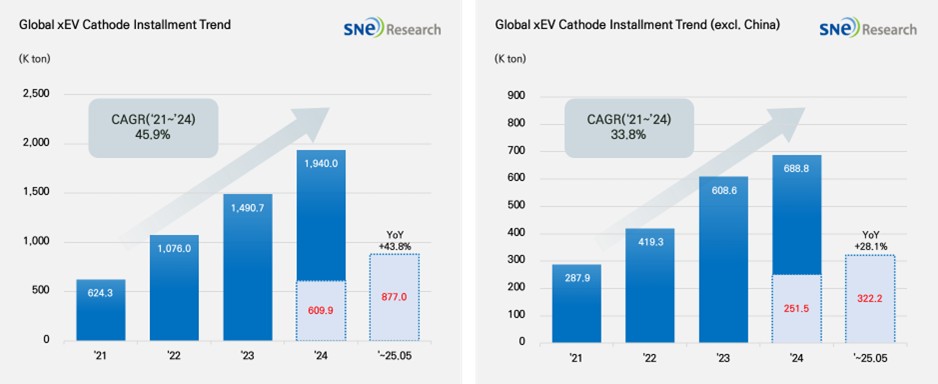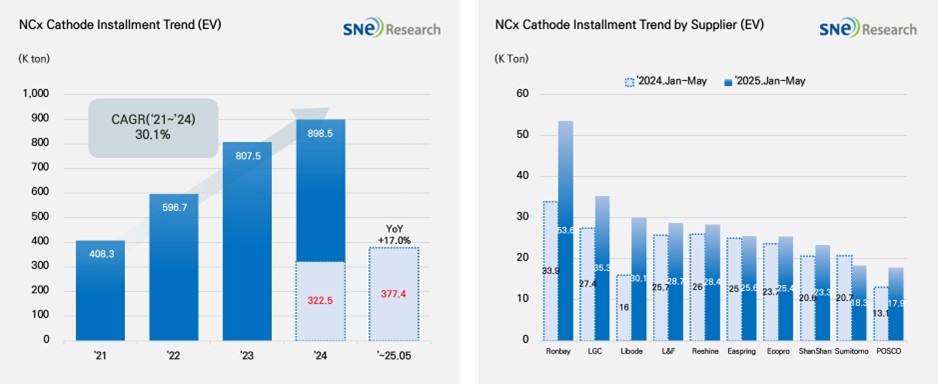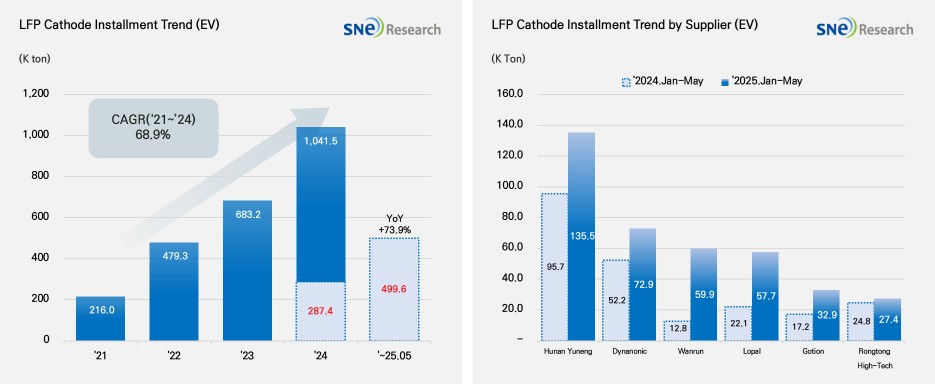From Jan to May in 2025, Global[1] Electric Vehicle Battery Cathode Material Installment[2] Reached 877.0K ton, a 43.8% YoY Growth
- From Jan to May in 2025, EV battery cathode material
installment in non-China market was 322.2K ton, posting 28.1% growth

(Source: 2025 June Global EV & Battery Monthly Tracker (Incl. LiB 4 Major Materials), SNE Research)
From Jan to May in 2025, the total installment of cathode materials used in electric vehicles (EV, PHEV, HEV) registered worldwide was approximately 877.0K ton, posting a 43.8% YoY growth. In particular, the installment of cathode materials used in electric vehicles in the non-China market recorded 322.2K ton, exhibiting a 28.1% stable growth.
Cathode material is a key material determining the capacity and output value of lithium-ion battery, upon which the performance of battery and driving range of electric vehicles depend. Currently, the battery market can be divided into the one centered around NCx ternary cathode material and the other mainly led by LFP cathode material, and both are driven by technical and economic advantages of each cathode material. Amidst the diversification of global cathode material demand, NCx ternary cathode material and LFP cathode material are positioning themselves as two main axes in the market.
If we look at the market by different cathode materials, the installment of ternary cathode material during the relevant period was 377.4K ton, posting a 17.0% YoY growth and continuously growing at a gradual pace. By company, Ronbay and LG Chem ranked 1st and 2nd, leading the market, while Libode settled in the 3rd place with 30.1K ton based on the increasing demand for mid-Ni cathode material. L&F(29.1K ton) and Ecopro(25.4K ton) also entered the upper rank, keeping their presences in the market as K cathode suppliers. Overall, however, the growth of Chinese cathode material makers showed a noticeable growth. Major cathode suppliers such as Reshine, Easpring, and ShanShan are competing fiercely, and the Chinse cathode makers are gradually expanding their global market shares based on demand from the Chinese domestic market and their massive ramp-up plans.

(Source: 2025 June Global EV & Battery Monthly Tracker (Incl. LiB 4 Major Materials), SNE Research)
During the same period of time, the total installment of LFP cathode material was 499.6K ton, recording a rapid growth of 73.9% compared to the same period of last year. Among the total cathode material installment, the proportion taken by LFP was about 57%(based on weight), which was beyond half the entire market share. It proved that the influence of LFP chemistry and LFP cathode materials has been further increasing in the market. It is interpreted as being affected by the expansion of entry-level EV market in China, increasing preference to LFP chemistry with price competitiveness, and increasing adoption of LFP batteries by global OEMs. By cathode suppliers, Hunan Yuneng(135.5K ton) and Dynanonic(72.9K ton) ranked 1st and 2nd on the list, solidifying their dominance in the market. Wanrun(59.9K ton) and Lopal(57.7K ton) ranked 2nd and 3rd based on their growth which was more than two times that of last year. Other than these, Gotion, and Rongtong High-Tech are expanding their market shares by supplying more than 20K tons per each. The top 5 were all taken by the Chinese cathode manufacturers, clearly showing that the LFP cathode market is practically dominated by China. The growth of LFP cathode material market is directly connected to the reinforcement of global dominance by the Chinese material companies, which ultimately would lead to solidify the China-centered structure in the global supply chain for battery material.

(Source: 2025 June Global EV & Battery Monthly Tracker (Incl. LiB 4 Major Materials), SNE Research)
[2] Based on batteries installed to electric vehicles registered during the relevant period.

